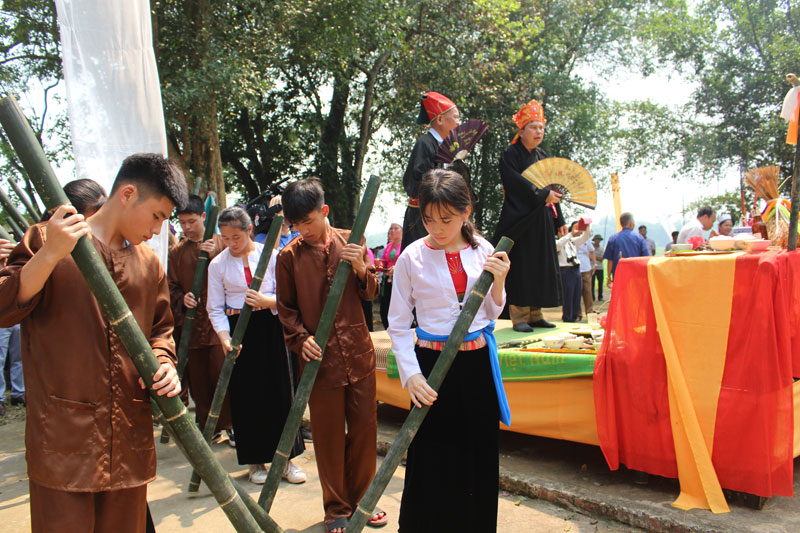
(HBO) - The People’s Committee of Lac Son district, the northern mountainous province of Hoa Binh, has held a ceremony to receive a certificate recognising the festival at Truong Kha temple, in Lien Vu commune, as a provincial cultural and historical relic site, and reenact the festival. The reenactment of the festival aims to satisfy spiritual and cultural demands of local people and contribute to preserving and upholding cultural values of the festival.
 A ritual
at the Truong Kha temple festival to pray for favourable weather conditions and
bumper crops.
A ritual
at the Truong Kha temple festival to pray for favourable weather conditions and
bumper crops.
The
Truong Kha temple in Chieng hamlet, Lien Vu commune was built in the 15th
century. It was restored in 1997 and rebuilt in 2013 by local people, using capital
mobilised from individuals and organisations.
The
elderly in the commune said the temple is dedicated to three Kun Dol Gods who
protect crops of the Muong ethnic minority group, and are worshipped by locals
in the ancient Voi-Trao area as tutelary gods.
Legend
has it that long time ago, the locality was hit by a drought that made the water
level of Buoi River shrink to a puddle in its bottom
located in Khoang Kha. The drought chapped fields and hampered rice growth. Muong
people suffered hunger and most of them had to leave their home to earn their
daily bread. At that time, the ancestor of Bui Van Xuom in Muong Trao could not
go because of his dog’s disobedience. One night when he was hesitating over
whether to leave or not, he heard sounds made by a small bird from an egg-plant
under which the dog often lay down. In the next morning, he found that the rice
fields were ripe, and asked other families in the hamlet to harvest.
Recalling
the bird sounds, he considered them a good signal from the three Kun Dol Gods. He
sacrificed a white buffalo as an offering to the Gods to pray for rain. Three
days later, the rain finally came. To show their gratitude towards the Gods,
local people built a temple to worship them and honoured them as tutelary Gods.
Since
then, local Muong people opened a festival at the temple on the 15th day of the
third lunar month triennially to pray for rain. This is an important religious
and cultural event, drawing the participation of all residents in the ancient
Voi-Trao area. It features various rituals, including the procession of the
Gods, buffalo sacrifice, rain praying and fishing.
It
also includes traditional games of Muong people like wrestling, swimming,
diving and rowing, along with other sport and cultural activities.
Through
these rituals and games, festival-goers show their gratitude and respect to the
Gods.
The
re-enactment aims to satisfy cultural and spiritual demands of people in Lac
Son district and Lien Vu commune in particular, contributing to preserving and
upholding heritage values in the locality./.
Hoa Binh province has carried out multiple programmes and initiatives to revive its cultural heritage which has gradually fallen into oblivion through the ebbs and flows of history.
The most prominent and defining feature in the prehistoric era of Hoa Binh is the Hoa Binh Culture. The Culture was first discovered in Hoa Binh. The significant prehistoric culture represents not only Vietnam but also Southeast Asia and southern China. Through excavations of cave sites in the limestone regions of Hoa Binh, French archaeologist M. Colani introduced the world to a "Stone Age in Hoa Binh province – Northern Vietnam" in 1927. On January 30, 1932, the First Congress of Far Eastern Prehistorians, held in Hanoi, officially recognised the Hoa Binh Culture.
Known as the "Land of Epic History”, Hoa Binh province, the gateway to Vietnam’s northwest, boasts a strategic location and a unique cultural tapestry woven by its ethnic minority communities.
The People's Committee of Luong Son District recently held a ceremony to receive the certificate recognizing Sau Communal House in Thanh Cao Commune as a provincial-level historical and cultural site.
Recognising the importance of cultural heritage preservation in protecting and promoting the value system of Vietnamese culture, and serving socio-economic development in the new period, Party committees and local administrations in Hoa Binh province have identified it as a key task in the cultural development strategy. The province has been making efforts in mobilising resources, creating consensus among people and engaging ethnic communities in preserving and promoting cultural identity.
Hoa Binh province has captured growing attention both domestically and internationally for its distinctive cultural heritage and rich history. Most notably, it has been renowned for its famous Hoa Binh culture, considered the cradle of ancient Vietnamese civilisation. Looking ahead to significant milestones in 2025 and the 140th anniversary of province establishment in 2026, Hoa Binh Newspaper presents a comprehensive overview of the province's development across economic, social, cultural, tourism, and security domains.



 A ritual
at the Truong Kha temple festival to pray for favourable weather conditions and
bumper crops.
A ritual
at the Truong Kha temple festival to pray for favourable weather conditions and
bumper crops.